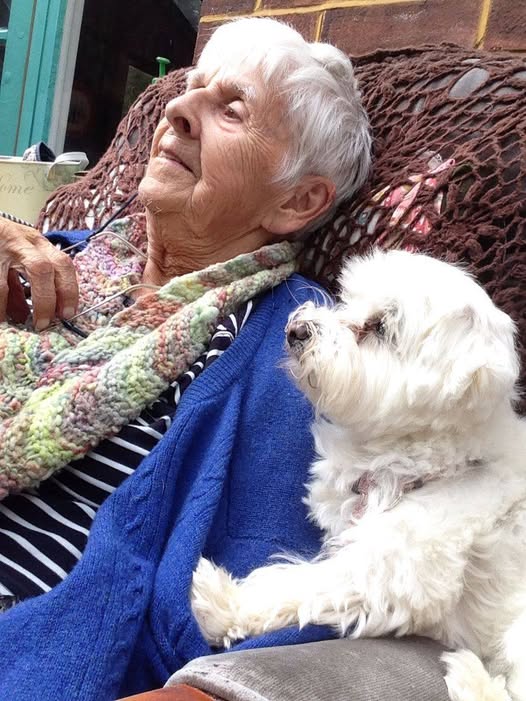Eternal Bond: The Story of a Woman, Her Dog, and the Love That Endures

Eternal Bond: The Story of a Woman, Her Dog, and the Love That Endures
In a quiet neighborhood where the days flow gently like a stream, nestled beneath blooming hibiscus and whispering old trees, stood a small house rich with memories. Within its modest walls, love had quietly flourished for fifteen years between a woman of grace and wisdom, and her beloved white dog. Theirs was not a loud love. It didn’t require words or grand gestures. It lived in routines, in looks exchanged across rooms, in the soft creak of a rocking chair and the thump of a tail on the wooden floor. It was the kind of bond that formed slowly and deeply, until it felt as natural as breathing.
Fifteen years earlier, on a rainy afternoon, the woman found the dog—just a pup then—shivering beside a bus stop, his thin coat soaked, his eyes clouded with fear. Without hesitation, she scooped him up, wrapped him in her warm shawl, and brought him home. That very moment became the quiet spark that would ignite a lifelong connection. She named him Bạch, for his snow-white fur, and from that day forward, they were never apart. He became her shadow, her soft-footed guardian, her reason to wake up with a smile each morning.

Their life together was simple, yet rich in the kind of moments that most overlook. Morning tea on the porch, shared biscuits, quiet walks in the park where the sunlight filtered through the trees and painted gold on both their faces. Neighbors would often pause and smile as they passed, the woman in her signature blue cardigan and colorful shawl, the dog walking proudly beside her, head high, tail swaying gently. There was something about them—an unspoken harmony—that made you feel as though they had grown from the same root.
As the seasons passed, both aged gracefully. The woman’s steps became slower, her fingers a little stiffer, but her spirit remained bright, like the morning sun through her kitchen window. Bạch too grew older—his fur lost some of its shine, his energy mellowed—but his devotion only grew stronger. They adapted to each other’s pace. She would rest more often on their walks, and he would sit patiently beside her. In the evenings, he would curl beside her chair as she read aloud, his ears twitching at the rhythm of her voice. In the silence, they communicated in glances and breath. No words needed, for their hearts understood each other in full.
But time, as it always does, moved on. And on August 5, 2025, at precisely 3:14 PM, something changed. The house, once so full of presence, softened into stillness. The woman had wrapped herself in her favorite shawl that morning. She fed Bạch his favorite meal—chicken with sweet potato—and had settled into her chair by the window. The sunlight poured in softly, warming the floor around them. Bạch lay at her feet, as always. Her knitting rested in her hands. She took a breath—and then another—and then, without a word, she slipped away as peacefully as a candle going out.

There was no sound. Just the faint ticking of the clock and the quiet presence of a dog who suddenly felt the world shift beneath him. Bạch didn’t move at first. He simply looked up, as if expecting her to stir, to whisper his name like she always did. But the room was silent. The kind of silence that sinks deep into the walls, into the floor, into fur and bone and memory.
Since that moment, Bạch has remained by her chair. Her shawl still drapes over the armrest. Her teacup still rests, half-full, on the small wooden table beside her. He doesn’t bark, doesn’t whimper. He simply waits—with eyes that carry the weight of love and loss, with a heart that beats slower now, but no less loyal. His world has changed, but his purpose hasn’t. He still guards her, even in absence.
Those who visit say the grief in the house is palpable, but it is not just human grief—it is the silent mourning of a creature whose soul has been intertwined with another’s. Bạch eats less now. He doesn’t play. He no longer reacts to the sound of footsteps at the door. Instead, he curls into her sweater at night, as if hoping to catch a fading trace of her scent, her warmth. He lies on the garden path they used to walk, his eyes scanning the horizon, searching not for rabbits or butterflies, but for the shape of the woman he loved.
What do we do with grief like this? How do we comfort a dog who has lost his person, the one he built his world around? The answer is simple, though not easy—we sit beside him. We whisper softly. We let him mourn. For grief, especially this kind, cannot be rushed. It is love that has nowhere to go, and it must find its own way to settle.

The woman had no family left, but the neighbors—touched by the bond she shared with her dog—have stepped in. A kind woman now cares for Bạch. She feeds him gently, strokes his fur, speaks to him as though his heart still listens for the voice he’s lost. And it does. Grief does not erase love; it merely reveals how deep that love runs.
Her chair remains untouched. Not out of denial, but respect. It is more than furniture now. It is a shrine to the thousands of hours spent in each other’s presence—the quiet humming, the shared meals, the silent companionship of two beings who found home in each other. The light still falls across the seat every afternoon, just as it did on that final day. Bạch still watches it.
There’s something in the loyalty of dogs that reaches beyond this world. Perhaps it’s their ability to live in the moment that allows them to love so fully. Or perhaps it’s that they see us for who we truly are—without expectation or judgment. The bond between this woman and her dog wasn’t extraordinary because of anything dramatic. It was extraordinary because it lasted, and deepened, and remained honest from the first day to the last.
Some say that when we die, our pets wait for us. That across some cosmic bridge, they sit patiently, tails wagging, ears perked, waiting to hear our footsteps once more. If that is true, then Bạch’s vigil will not be in vain. Until then, he carries the weight of both their love.

He is not just a dog. He is memory made flesh. A living chapter of a story that continues even in absence. He teaches us, in his silence, that love does not vanish. It lingers—in fur left on the carpet, in tea cups left on the table, in well-worn shawls and favorite garden paths. And most of all, in the quiet gaze of a dog who once belonged entirely to someone, and now belongs to her memory.
So if you ever pass by a house where a white dog sits silently beside an empty chair, know this: you are witnessing something sacred. A bond that defies time. A love that endures past breath. A heart still waiting—not in despair, but in devotion. And perhaps, in that waiting, there is hope for us all.
There were days of laughter, like when Bạch chased the neighborhood rooster only to trip on a rake and land in a pile of raked leaves. She had laughed so hard she cried, and then he leapt into her arms as if embarrassed. There were also difficult times—like the year she fell and fractured her hip. Bạch stayed beside her during recovery, refusing to eat unless she was beside him. The nurses were astounded by his behavior. “He watches over her like a husband,” one of them said. And in a way, he did.
Their home became a place of ritual. The scent of jasmine tea, the sound of classical music on rainy afternoons, the low hum of her voice reading aloud—all of it shaped a rhythm as gentle and essential as breathing. Even storms couldn’t shake their peace. Bạch was afraid of thunder, and during those booming summer nights, she would wrap them both in the old patchwork quilt and speak softly unt

When she passed, Bạch remained the keeper of that rhythm. He guarded not just her belongings but the invisible threads of their life together. Her presence lingers in the smallest things: the frayed edge of her knitting basket, the faint perfume on a pillowcase, the way the afternoon light bends across the kitchen tiles. Bạch notices it all. In his stillness, he holds vigil for the ech
And that is the quiet miracle of animals—they absorb our sorrow and turn it into presence. They become keepers of memory, containers of the love we thought we had nowhere to put. Bạch doesn’t need to speak. In every slow blink, in every step across the floor, he says: I remember. I still love. I still wait.
If you’ve ever loved someone so deeply that their absence rewrote your days, you know what Bạch feels. He is not a symbol. He is a heart beating under fur. He is grief softened by time, devotion shaped into silence. And he teaches us what it means to love without needing anything in return—not food, not praise, not even understanding. Just love, plain and enduring.
So the next time you see a dog sitting beside an empty chair, don’t look away. Sit for a moment. Feel what he feels. Let yourself believe that the bonds we make in this life leave imprints beyond death. And when you rise, carry that feeling with you—into your next embrace, your next act of care, your next goodbye.
Because somewhere, a white dog is still waiting. And in his waiting, he reminds us: true love never leaves. It simply takes a new form.








